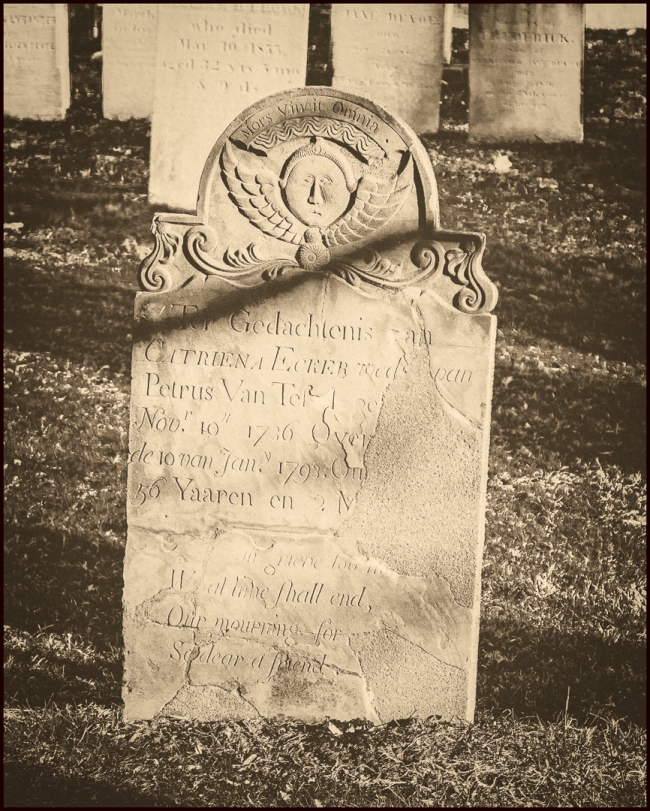The face of the red sandstone grave marker may be slowly flaking away, but the memory of Catriena Ecker van Tassel will live forever. In Washington Irving’s short story The Legend of Sleepy Hollow, hapless schoolmaster Ichabod Crane is smitten by the comely 17 year old Katrina van Tassel, but he must compete with town thug Abraham ‘Brom Bones’ van Brunt. Folklorists say that the character Katrina van Tassel is based on Eleanor van Tassel Brush, although the character’s name is based on Eleanor’s aunt Catriena Ecker van Tassel. Her grave is without a doubt the most visited grave in the Old Dutch Burying Ground. The area around Catriena Ecker van Tassel’s grave is peppered with other members of the van Tassel family. The latin inscription, Mors Vincit Omnia, topping her gravestone translates to “Death Conquers all”. (Stories in Stone New York. A field guide to New York City area Cemeteries and their residents by Douglas Keister)
Irving describes Katrina as follows:
Among the musical disciples who assembled, one evening in each week, to receive his instructions in psalmody, was Katrina Van Tassel, the daughter and only child of a substantial Dutch farmer. She was a blooming lass of fresh eighteen; plump as a partridge; ripe and melting and rosy-cheeked as one of her father’s peaches, and universally famed, not merely for her beauty, but her vast expectations. She was withal a little of a coquette, as might be perceived even in her dress, which was a mixture of ancient and modern fashions, as most suited to set off her charms. She wore the ornaments of pure yellow gold, which her great-great-grandmother had brought over from Saardam; the tempting stomacher of the olden time, and withal a provokingly short petticoat, to display the prettiest foot and ankle in the country round.
Note the winged head on the gravestone. According to Angels and Ghosts:
On the East coast of the United States, skilled artisans were hired by people in the 1600 and 1700s, often before their deaths, to create elaborate gravestone carvings. New England cemeteries, consequently, are reknowned for having an abundance of burial sites with winged cherubs and souls adorning the markers of the deceased.
Prior to winged souls and flying cherubs decorating graveyards, however, morbid ideas of death were carved into markers for about 60 years. These ‘death heads’ were just as significant as the ‘soul effigies’ and ‘winged cherubs’ that would eventually follow; for all of these types of stone carvings reveal a shift in American culture away from dogmatic religious beliefs to more of a free spirit mindset. This change in gravestone carvings began around 1630 and continued through the 18th century. People were moving away from condemning Puritan beliefs that focused more on frightening ideas of eternal suffering, namely Hell. The populous was preferring a non-condemning take on the afterlife, something more spiritual, let’s say.
Early Winged Gravestone Art
The first carvings that were made were not the pleasant winged cherub or human faces. Preceding the lighter, angelic facial expressions were carvings of skulls or even skulls with crossbones. These skull motifs are known as ‘death’s heads’ – non-religious symbols found on the markers that sometimes bore wings. Skulls were prominent on gravestones between 1630-1690. The messages of the skeletal iconography seem to suggest that whatever happens to the soul after death was not known, as far as its journey or fate; but death had come calling for its victim – that was certain. The wings, when used, however, also might have conveyed the hope of rescuing the dead from the earth plane, or even hell, taking them up into the heavens and a higher estate.
Winged Cherubs on Cemetery Stones
Cherubs eventually began to replace the skulls, beginning in the 1690s, as a way to indicate a childlike innocence, a higher wisdom about life, and, of course, the hope of a resurrection and an afterlife. Cherubs with wings, essentially angels, were much more soothing than skulls and bones to say the least. And the new, positive outlook on the afterlife began to show in headstone epitaphs, too. Positive sayings began replacing grim warnings used in the past.
These ‘winged effigies’ might look like angels, but they often were artist depictions of either cherubs or, possibly, the human soul. When we look at the faces between the wings, we might catch the artist imagining the person’s soul (think human face here instead of a chubby little angel face) being lifted upward to the heavens. Along with the carving of the soul, at times, the shape of the stone or the carving itself indicated an archway, or entrance path, into the afterworld.
Taken with an Olympus OM-D EM-10 and Panasonic Lumix G Vario 14-42 f3.5-4.6 II

